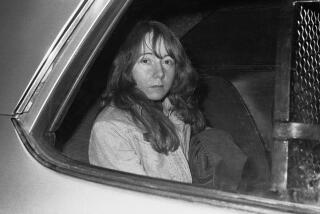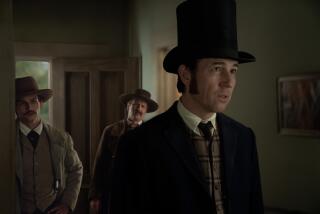In Footsteps of John Wilkes Booth
- Share via
WASHINGTON — Two strangers, one with a broken leg, arrived at the Maryland farmhouse of Dr. Samuel Mudd early on April 15, 1865. Dr. Mudd set the injured man’s leg and afterward invited his patient and guest to rest in a spare bedroom.
The patient was John Wilkes Booth, who hours earlier had fatally shot President Abraham Lincoln at Ford’s Theater in Washington, D.C., about 30 miles away.
For setting the leg of Lincoln’s assassin, Dr. Mudd was tried and found guilty of conspiracy to murder Lincoln and sentenced to life in prison.
Dr. Mudd’s wood-frame house still stands, as does Ford’s Theater and other major sites where Booth stopped on his escape from Washington.
Fascinated by the Crime
Because of so much interest in the crime the Surratt Society, a volunteer organization operating the Surratt Tavern, another Booth-related landmark, sponsors bus tours retracing Booth’s steps from Ford’s Theater to the site of Garrett’s Farm, where Booth died.
The John Wilkes Booth Escape Route Tour is offered twice a year, during April and September. Tours are generally booked far in advance, and third and fourth tours are sometimes scheduled to accommodate those on waiting lists.
An alternative is to guide yourself through Booth’s escape route. Many of the roads traveled by Booth still exist, and four buildings associated with the assassination are open to the public.
Lincoln went to Ford’s Theater to see “Our American Cousin.” Booth sneaked into the President’s box and shot Lincoln in the back of the head.
The assassination was part of a conspiracy. Initially, Booth and six others met in the Surratt Boarding House on H Street in Washington, and plotted to kidnap the President.
One was John Surratt Jr., son of the owner of the house, Mary Surratt.
After those plans went awry, three conspirators, including Surratt, bowed out.
The Plot Turned
As the Civil War came to an end the plot turned from kidnaping to murder. Booth schemed to kill Lincoln while his compatriots would murder Vice President Andrew Johnson and Secretary of State William Seward. Only Booth was successful, shooting Lincoln at 10:15 p.m. on April 14.
Two months after the assassination, owner John T. Ford planned to reopen his theater, but an indignant public protested.
As a result, the brick showplace on 10th Street wasn’t reopened as a theater until 1968. Thanks to a painstaking restoration during the 1960s, it looks as it did the night of April 14, 1865.
Reproduction American flags drape the presidential box, where the President and Mary Lincoln sat with two guests. An original framed engraving of George Washington hangs from the box as it did that night.
You can’t enter the presidential box today but can peer inside through a glass panel. Crimson damask furniture, including an original sofa, set off the box. Lincoln sat in a rocker like the one near the door, within easy reach of Booth’s outstretched arm.
Booth escaped by jumping from the presidential box to the stage floor and running out a back door.
Normally the 11-foot, 6-inch jump would have been easy for the agile Booth. But he caught a spur on a flag draping the box, lost his balance and broke the lower bone in his left leg.
If you visit at the right time, take a seat in the balcony and listen to a National Park Service guide weave the tale of that infamous night and the idiosyncrasies of the theater that Booth knew so well.
The Grisly Relics
The basement museum, however, is being refurbished and will not reopen until April of next year. All the grisly relics, such as Booth’s single-shot derringer pistol and the suit Lincoln wore to the theater, are in storage.
While Booth was riding horseback toward the Navy Yard Bridge and Maryland, the President was carried across the street to William Peterson’s house, a narrow, red-brick structure typical of many in Washington at that time.
After Lincoln died in a rear bedroom, Victorian era tourists continually paraded by, hoping for a peek inside. Finally, in 1880, Congress began efforts to memorialize it.
More than 100 years later the curious come for the same reason. What they see is a home that looks virtually as it did in 1865.
In the bedroom where the President died the muted brownish wallpaper duplicates what was there in 1865. The furniture is of the same period, while the pillow, protected by a plastic cover, is the one on which Lincoln’s head rested.
Coats and a hat hang on hooks, and the rocking chair is similar to the one in which Secretary of the Navy Gideon Welles sat for hours watching over the dying Chief Executive.
Mary Lincoln spent a miserable night, grieving on the sofa in the front parlor. By midnight Secretary of War Edwin M. Stanton began interviewing witnesses in the adjacent rear parlor.
At the same time John Wilkes Booth and an accomplice, David Herold, were already 10 miles away in Surrattsville, now Clinton, Md., at the Surratt Tavern, picking up a carbine and field glasses.
Ran Boarding House
The tavern was operated through a lease by Mary Surratt, the same woman who ran the H Street boarding house where the conspirators met.
The tavern also served as a polling place and post office; original letters to Surrattsville are sorted and still waiting to be collected.
But look in a small storage room over the kitchen and you’ll see something a little more foreboding--a carbine like the one Booth meant to take on his escape.
Herold took a gun but Booth declined, claiming he couldn’t carry one because of his broken leg, which forced him to stop at Dr. Mudd’s house at about 4 a.m.
Unlike the staff at the Surratt Tavern, which takes no sides regarding the guilt or innocence of the conspirators, the Mudd Society offers tours of Dr. Mudd’s Waldorf, Md., home from the premise that he was innocent.
On the morning of April 15, 1865, after the doctor set Booth’s leg on the velvet sofa in the parlor he sent him upstairs to rest in the spare bedroom now called the Booth Room.
Whether Mudd should have been sent to prison is still being debated by historians. Booth apparently knew the doctor’s name when he knocked on the door that April morning, and evidence shows that the two had met before.
It is also known that Booth wore false whiskers when he arrived at the doctor’s house after shooting Lincoln, and it is possible that Mudd didn’t recognize Booth.
In any case, after serving four years of a life term Mudd was pardoned by President Andrew Johnson in 1869.
The law finally caught up with Booth at Garrett’s Farm four miles outside Port Royal, Va. Herold surrendered, but Booth refused. Although some historians claim that he committed suicide, he most likely was shot and killed by Union troops.
The only tangible evidence of Booth’s Waterloo is a historic marker in the median strip of U.S. 301. It reads:
“This is the Garrett place where John Wilkes Booth, assassin of Lincoln, was cornered by Union soldiers and killed April 26, 1865. The house stood a short distance from this spot.”
Ford’s Theater and the House Where Lincoln Died are open daily, except Christmas, 9 a.m. to 5 p.m. Admission is free. For more information, contact the Site Manager, Ford’s Theater, 511 10th St. N.W., Washington, D.C. 20004, (202) 426-6924.
The Surratt Society will offer the John Wilkes Booth Escape Route Tour next Saturday and again Sept. 9. It costs $27 per adult. Because the tour lasts 12 hours, it is not recommended for children under 12. For more information, contact The Surratt Society, P.O. Box 427, Clinton, Md. 20735, (301) 868-1121.
The Surratt Tavern, at 9110 Brandywine Road in Clinton (use The Surratt Society phone number), is open March through December, Thursday and Friday, 11 a.m. to 3 p.m., and Saturday and Sunday, noon to 4 p.m. The last tour starts half an hour before closing time.
Admission is $1 for adults, 75 cents for seniors, 50 cents for children.
The Dr. Samuel A. Mudd Museum is open from late March to November, Saturday and Sunday, noon to 4 p.m. Admission is $3 for adults, 75 cents for children. Samuel A. Mudd Society, P.O. Box 1043, La Plata, Md. 20646, (301) 645-6870 or (301) 934-8464.
More to Read
Sign up for Essential California
The most important California stories and recommendations in your inbox every morning.
You may occasionally receive promotional content from the Los Angeles Times.










